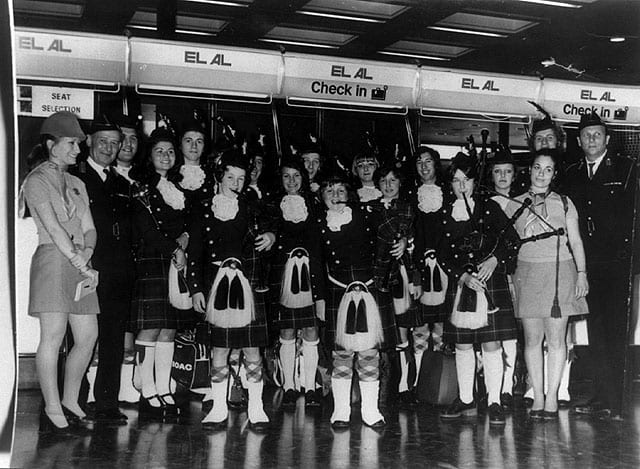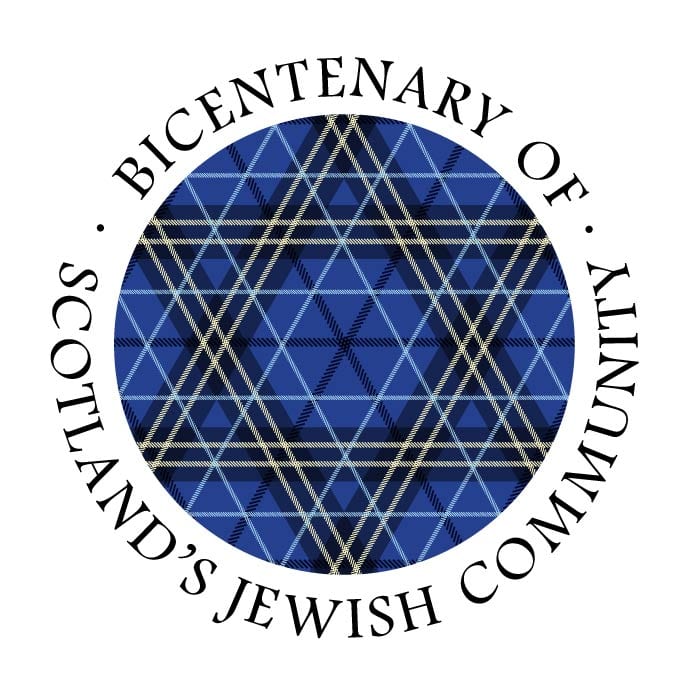Tartan, a checkered pattern that is formed when the same set of colored bands intersect horizontally and vertically, is one of the defining visual features of Scottish culture. Tartan is taken so seriously, in fact, that there is official legislation defining tartan and the process of registering it officially. Historically, tartan was associated with the Highlanders, but as time went on tartan became popular throughout Scotland, and became of way of demonstrating an affiliation with a particular clan. As it grew in national importance, tartan became an important part of Scottish culture, and a means by which a person could express their identification as Scots, and their sense of belonging within Scotland.
Tartan became increasingly popular during the first half of the 19th century; 1822 saw the start of a tartan craze, during which many in Scotland began identifying themselves with various clans, and wearing tartans that had become associated with those clans. Jews, however, were not part of this phenomenon. One reason is because there simply weren’t very many living in Scotland at this time; though Jews were first recorded in Scotland in the late 17th century, they did not arrive in any significant numbers until the late 19th century.

Not only were these newcomers clearly not affiliated with any of the historical clans, they were also just beginning to settle in their new home and learn what it meant to be Scottish. During this period of immigration and transition, the idea of tartan and its significance would not have been the foremost issue on their minds.
As time went on, however, Jewish communities began to be established (chiefly in Glasgow and Edinburgh) and Scotland’s Jews began to make increasing inroads into Scottish society—including establishing the world’s only Jewish bagpipe band within the Glasgow Jewish Lads and Girls Brigade youth movement. As Scotland’s Jews began to feel more at home in the country, it was almost inevitable that the community would want a tartan that represented Scottish Jewry.
Finally, in 2008, Clive Schmulian, a member of Glasgow’s Jewish community, created the first Jewish tartan, the Shalom Tartan, and worked with journalist Paul Harris to publicize the tartan among Scottish Jewry. The Shalom Tartan is made up of lines that are white, black, and two shades of blue, and is designed to represent the Scottish and Israeli flags.
The Shalom Tartan was followed shortly thereafter by a tartan designed by Rabbi Mendel Jacobs and Brian Wilton of the Scottish Tartans Authority. Like the Shalom Tartan, Rabbi Jacobs sought to infuse the new Jewish tartan with meaning. Similar to the Shalom Tartan, the blue and white lines serve to integrate the Scottish flag with the Israeli flag. A gold line represents the gold of the Ark of the Covenant, the silver line represents the Torah, and a deep red line represents Kiddush wine. This tartan’s pattern has seven lines in the central motif, and three in the flag representations; three and seven are both significant numbers in Jewish tradition. Additionally, both Rabbi Jacob’s tartan and the Shalom Tartan were designed to be “kosher tartan,” consisting only of wool, and not wool and linen, a mixture that is forbidden according to Jewish law.

In addition to creating their own tartans, Scotland’s Jews have also managed to have fun with the concept. Ephraim Borowski of the Scottish Council of Jewish Communities created a “visual pun” that combined tartan-style interwoven bands of color with the Star of David. This design was subsequently used for the SCoJC’s bicentenary events.
Over time, tartan patterns have become symbols of belonging, a clear visual demonstration of a fundamental connection with a particular group, and with what it means to be Scottish. Jewish tartan allows Scottish Jews to be part of this very Scottish tradition, while also acknowledging their connection with other Jews, and their belonging to a unique Scottish-Jewish clan.

For more information about the Jews of Scotland, please visit the Scottish Council of Jewish Communities, https://www.scojec.org/index.html, and the Scottish Jewish Archives Centre, https://www.sjac.org.uk/.